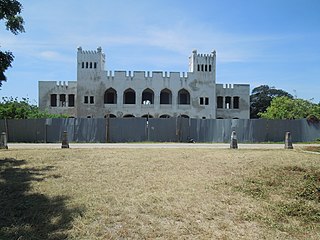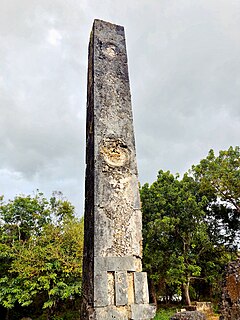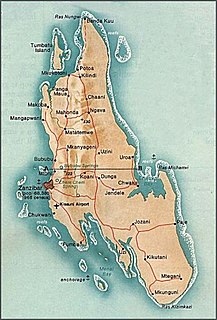Related Research Articles

Tanzania, officially the United Republic of Tanzania, is a country in East Africa within the African Great Lakes region. It borders Uganda to the north; Kenya to the northeast; Comoro Islands and the Indian Ocean to the east; Mozambique and Malawi to the south; Zambia to the southwest; and Rwanda, Burundi, and the Democratic Republic of the Congo to the west. Mount Kilimanjaro, Africa's highest mountain, is in northeastern Tanzania.
The African Great Lakes nation of Tanzania dates formally from 1964, when it was formed out of the union of the much larger mainland territory of Tanganyika and the coastal archipelago of Zanzibar. The former was a colony and part of German East Africa from the 1880s to 1919’s when, under the League of Nations, it became a British mandate. It served as a British military outpost during World War II, providing financial help, munitions, and soldiers. In 1947, Tanganyika became a United Nations Trust Territory under British administration, a status it kept until its independence in 1961. The island of Zanzibar thrived as a trading hub, successively controlled by the Portuguese, the Sultanate of Oman, and then as a British protectorate by the end of the nineteenth century.

Pemba Island is a Tanzanian island forming part of the Zanzibar Archipelago, lying within the Swahili Coast in the Indian Ocean.

Mafia Island is an island and district of Pwani Region, Tanzania. The island is the third largest in Tanzanian ocean territory, but is not administratively included within the semi-autonomous region of Zanzibar, which has been politically separate since 1890. Mafia Island forms the major part of Mafia District, one of the six administrative districts in the Pwani coastal region. The local archipelago and the main island are sometimes called Chole shamba in Swahili, hinterlands of the former maintown of Chole on Mafia Bay.

Tanga is both the name of the most northerly port city of Tanzania on the west of the Indian Ocean, and the capital of Tanga Region. It had a population of 273,332 in 2012. The name Tanga means "sail" in Swahili.

Kilwa Kisiwani is an island, national historic site, and hamlet community located in the township of Kilwa Masoko, the district seat of Kilwa District in the Tanzanian region of Lindi Region in southern Tanzania. Kilwa Kisiwani is the largest of the nine hamlets in the town Kilwa Masoko and is also the least populated hamlet in the township with less than 1,000 residents. At its peak Kilwa hosted over 10,000 inhabitants in the Middle Ages. Since 1981 the entire island of Kilwa Kisiwani has been designated by UNESCO as a World Heritage Site along with the nearby ruins of Songo Mnara. Despite its significant historic reputation, Kilwa Kisiwani is still home to a small and resilient community of native residents that have inhabited the island for centuries. Kilwa Kisiwani is one of the seven World Heritage Sites located in Tanzania.

Bagamoyo, is a coastal town founded at the end of the 18th century, though it is an extension of a much older Swahili settlement, Kaole. It was chosen as the capital of German East Africa by the German colonial administration and it became one of the most important trading ports for the Germans along the East African coast along the west of the Indian Ocean in the late 19th and early 20th century. Today, it is the capital of the Bagamoyo District in Pwani Region. In 2011, the town had 82,578 inhabitants.

Pangani District is one of the eight districts and one of 11 administrative councils in Tanga Region in north eastern Tanzania. As of the 2012 census, the population was Pangani district was 54,025, making it the least populous district in Tanga region. The district seat (capital) and largest settlement in Pangani district is the town of Pangani. The district is named after the historic Pangani River.

Arusha Region is one of Tanzania's 31 administrative regions. Its capital and largest city is the city of Arusha. The region is bordered by Kajiado County and Narok County in Kenya to the north, the Kilimanjaro Region to the east, the Manyara and Singida regions to the south, and the Mara and Simiyu regions to the west. Arusha region is home to Ngorongoro Conservation Area, a UNESCO World Heritage Site. The region is comparable in size to the combined land and water areas of the United States state of Maryland.

Following Tanganyika's independence (1961) and unification with Zanzibar (1964), leading to the formation of the state of Tanzania, President Julius Nyerere emphasised a need to construct a national identity for the citizens of the new country. To achieve this, Nyerere provided what has been regarded by some commentators as one of the most successful cases of ethnic repression and identity transformation in Africa.

The Tongoni Ruins are 15th century Swahili ruins of a mosque and forty tombs located in Tongoni ward in Tanga District inside Tanga Region of Tanzania. The area was a different place four to five centuries ago. Contrary to its almost unnoticed presence today, it was a prosperous and a respected Swahili trading centre during the 15th century. Most of the ruins are still not yet been uncovered.

Toten Island is a small uninhabited island situated north of the city of Tanga's harbour in Tanga Region, Tanzania. It is within the Tanga Bay. The island is administered by both the Tanzania Marine Parks and Reserves and the City of Tanga. The island is a historical site that contains ruins of two Medieval Swahili mosques and tombs. The current name comes from the German word for "dead bodies" alluding to the numerous graves on the island. Until 1854 Toten Island was still inhabited by people. In 1884 the remaining people moved to what is present day Tanga city.

Swahili architecture is a term used to designate a whole range of diverse building traditions practiced or once practiced along the eastern and southeastern coasts of Africa. Rather than simple derivatives of Islamic architecture from the Arabic world, Swahili stone architecture is a distinct local product as a result of evolving social and religious traditions, environmental changes, and urban development.

Swahili culture is the culture of the Swahili people inhabiting the Swahili coast. This littoral area encompasses Tanzania, Kenya, and Mozambique, as well as the adjacent islands of Zanzibar and Comoros and some parts of Malawi. They speak Swahili as their native language, which belongs to the Bantu language family. Graham Connah described Swahili culture as at least partially urban, mercantile, literate, and Islamic.

Pangani Town is a historic Swahili settlement located on the south eastern shore of Tanga Region, Tanzania. The town lies 45 km (28 mi) south of the city of Tanga, at the mouth of the Pangani River. It is the headquarters of the Pangani District. Administrately the town Pangani is situated within two wards, Pangani Mashariki and Pangani Magharibi. The town is currently the largest settlement in Pangani district and is a major tourist attraction in Tanga region.

Tumbatu Island is the third-largest island making up the Zanzibar Archipelago, part of Tanzania in East Africa. The island is located off the north-west coast of Zanzibar's main island, also known as Unguja.
The Ras Mkumbuu Ruins are located on the west coast of the Tanzanian island of Pemba, part of the Zanzibar Archipelago specifically in South Pemba Region. They lie close to the village of Ndagoni at the end of a long narrow peninsula known as Ras Mkumbuu, which lies to the northwest of the town of Chake-Chake.
Mkwaja is an administrative ward in Pangani District of Tanga Region in Tanzania. The ward covers an area of 408 km2 (158 sq mi), and has an average elevation of 37 m (121 ft). According to the 2012 census, the ward has a total population of 4,217. The name Mkwaja is derived after a Medieval Swahili city state on the coast of Mkwaja ward.

Mkama Ndume ruins was a medieval Swahili settlement that was abandoned in the 16th Century prior to Portuguese arrival and is known for its fortification. The site is located 10 km (6.2 mi) east of the town of Chake Chake in South Pemba Region of Tanzania. The settlement was ruled by a leader named Mohammed bin Abdul Rahman, who was known for his cruelty towards his subjects thus earned his infamous nickname Mkama Ndume meaning milker of men in old Swahili. The settlement ruins bear this nickname.
Yambe Island is protected, uninhabited historic island located directly east of the city of Tanga in Tanga Region, Tanzania. It is the largest island in Tanga region. It is located entirely with the Tanga Coelacanth Marine Park (TCMP). The island is administered by the Tanzania Marine Parks and Reserves. The island is also home to medieval Swahili ruins that have yet to be excavated.
References
- 1 2 "Antiquities Division | Ministry of Natural Resources and Tourism".
- ↑ "Atiquities Act 1964" (PDF).
- ↑ "Atiquities Act 1974" (PDF).
- ↑ "Atiquities Sites" (PDF).
- ↑ "Cultural Heritage Management in Tanzania's Protected Areas: Challenges and Future Prospects".
- ↑ Berry, L. (1975). In Tanzania in maps (pp. 98–99). essay, University of London Press.
This article needs additional or more specific categories .(December 2021) |